2023 Chambourcin in Detail
Last updated 10/22/2024
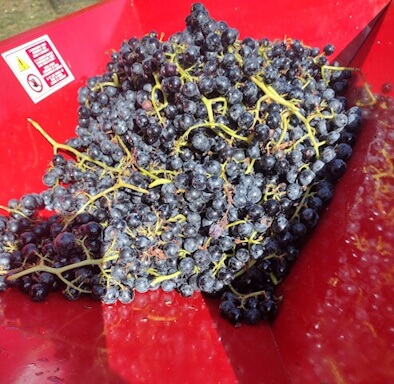
As I stated in my 2023 Vidal In Detail post, I didn’t expect to do more of these soon. They’re actually a lot of work, and I don’t want to repeat myself — each post should be sufficiently different from previous ones to justify the effort.
The Vidal is easy to justify, as I’m making a traditional white and an “orange” wine from the same grapes, so there’s something to talk about.
What’s special about this one? I’m using two totally different yeast strains from Renaissance, comparing and contrasting the results of the batches plus the wine that results from combining the two.
Batch #1 is inoculated with Renaissance Avante yeast, and Batch #2 is inoculated with Renaissance Bravo yeast. Post fermentation I will reserve a sample of both wines, but the majority will be blended.
Dates of Activity
| 10/07/2023 10/08/2023 10/09/2023 10/10/2023 |
10/11/2023 10/13/2023 10/26/2023 02/01/2024 |
02/06/2024 02/27/2024 10/22/2024 |
10/07/2023
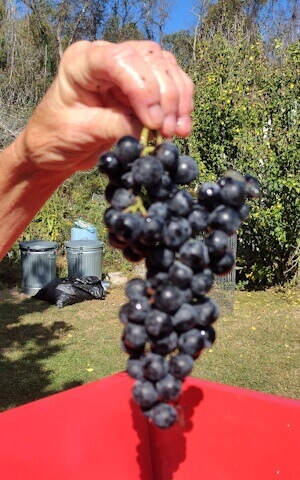 I purchased 120 lbs each Chambourcin and Vidal from my friends Beth & David, who own and operate Highland Meadow Vineyards in Glade Spring VA. It’s a four hour drive each way … which might lead me to question my own sanity … assuming I have any to question.
I purchased 120 lbs each Chambourcin and Vidal from my friends Beth & David, who own and operate Highland Meadow Vineyards in Glade Spring VA. It’s a four hour drive each way … which might lead me to question my own sanity … assuming I have any to question.
Beth & David picked grapes the day before, and we first crushed my Vidal and then what they were keeping. Then we crushed my Chambourcin. After that we crushed their Chambourcin and Chelois.
It was a long day, but it was worth it.
Unfortunately, when I got home, more work was on the agenda. I had to carry all the grapes through the house and down into the cellar.
Then I made starters with 2 tsp Avante and Bravo (respectively), 1/2 tsp Fermax, and 3 Tbsp sugar in 1 cup 92 F water. These are in wine bottles and will be used in the morning.
I always thought of yeast just being yeast. However, as the picture shows, the strains look different. The two on the left are Renaissance TR-313, which are for the Vidal batches I’m also starting today. The next one is Avante, and the one on the far right is Bravo.
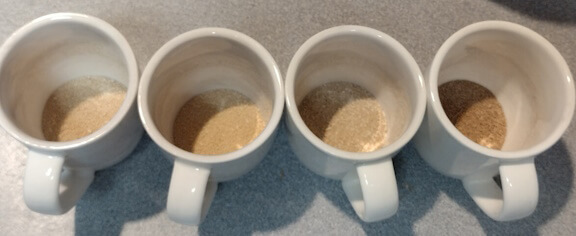
The color of the juice in the picture is Chambourcin after 4 hours of macerating while driving home. The juice was nearly that dark coming out of the crusher.
It might be possible to make a rose from this grape if the pulp is pressed immediately after crushing, but there’s no making a white wine. The color leaches from the skins immediately!
I divided the grapes more-or-less evenly among two 32 gallon Brutes, then added 3/4 tsp Scottzyme Color Pro to each.
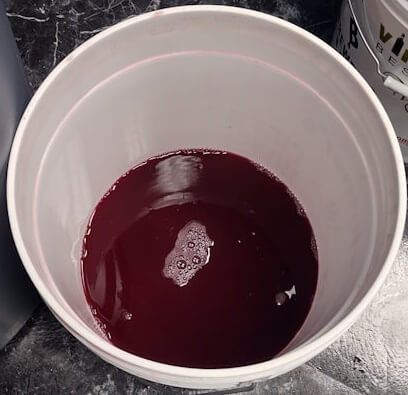
In this situation I’m not using Color Pro to get more color from the Chambourcin. For those not aware, most red grapes have white flesh and juice — the color comes from the skins. [The Teinturier class of grapes have red flesh and juice, but most do not.]
From the Scott Labs site:
- Wines appear to have deeper, darker, and more intense color.
- Gentle extraction of tannins which positively impacts wine structure.
- Mouthfeel is positively impacted; wines appear rounder and herbaceous and veggie characters are minimized.
- Improved clarity, yield, and filterability.
The last 3 points are valuable for this wine.
10/08/2023
Bright-n-early I checked the starters. We have ignition.
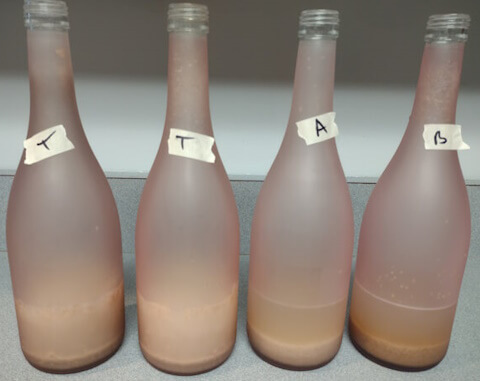
The grapes are VERY juicy — I have high hopes for the wine. I’m very exited!
I checked pH and brix. The sugar level is a bit low, so I added 2 cups of sugar to each, which if I have 4 gallons of wine in each will raise the SG by 0.010. My actual results are:
| Batch | pH | Orig SG | Adj SG |
|---|---|---|---|
| Batch #1 | 3.40 | 1.084 | 1.090 |
| Batch #2 | 3.24 | 1.084 | 1.090 |
As I noted in the Vidal In Detail post, the calculation is far from exact, as I don’t know for sure how much liquid is in the must. I was targeting a bit higher for SG, but 1.090 is satisfactory, so I’m going with it.
When I added the sugar I also added 3 tsp Fermax, then stirred the heck out of each batch. Then I checked SG. After that I added 2 cups American oak chips to each batch.
Oak added at fermentation time provides numerous benefits. It’s typically called “sacrificial tannin”, as tannin drops post-fermentation and the oak tannin will drop instead of the preferred grape tannin. The oak also helps keep the color stable and makes the wine smoother in the mouth.
Finally I inoculated Batch #1 with Avante and Batch #2 with Bravo. I’m interested in seeing how the wines progress.
10/09/2023
As I mentioned in the Vidal In Detail post, I’m punching down 3 or 4 times per day. With the Chambourcin, it’s really easy, as the grapes are VERY juicy. With less juicy grapes, it’s more of a chore as there are so much more solids.
10/10/2023
I checked SG this morning — the Avante is at 1.072 and the Bravo at 1.070. This is a LOT higher than the Vidal — both of those batches are at 1.032 this morning.
While that’s a surprise, the wines are fermenting so there’s no problem. The color is REALLY dark.
I was going to add 1 tsp Fermax to each batch this morning, but decided to add 2 tsp each. I think there’s more liquid in the fermenter than I expected, so adding more nutrient compensates for the extra volume. It may also spur the fermentation rate.
At this point I have not yet decided when to press. For the California grapes that will arrive in a couple of weeks, I’ll press at or shortly after fermentation completes. For this one, I’m thinking I’ll press when the SG hits 1.000. I don’t need extra color, and from what I’ve read soaking can extract a lot of tannin, which I don’t want. I have time to decide.
10/11/2023
I checked the SG of the Bravo this evening — 1.022. That’s a huge drop in 36 hours.
In the morning I’ll check SG again. We could press as early as tomorrow night.
10/13/2023
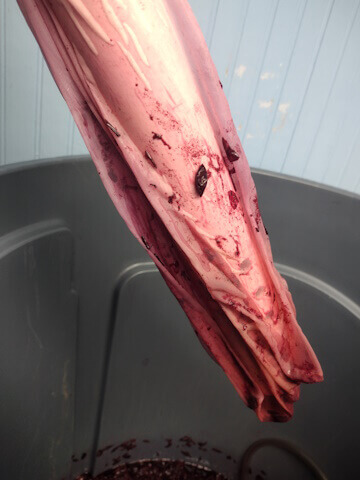
The Bravo batch’s SG was 1.012 yesterday morning, so my son and I agreed to press after work today. I wanted to wait until tomorrow morning, but heavy rain is forecast, so today it is.
I didn’t bother checking the Avante batch’s SG, as I figure they’re close enough that it doesn’t matter.
After racking, we checked the SG on the Bravo, and it was 0.997. I haven’t checked pH yet, although both batches are VERY tart. Hopefully acid will drop post-fermentation. If not, I’ll have to address it.
The plan is to rack as much of each batch out, reserving a couple of gallons of each batch. After basic clearing I’ll retain 1 US gallon of each batch, and the remainder will be blended into a single batch. Later we will compare the 3 wines, so we can see the differences between Avante and Bravo, and how they compare to a blend of the two.
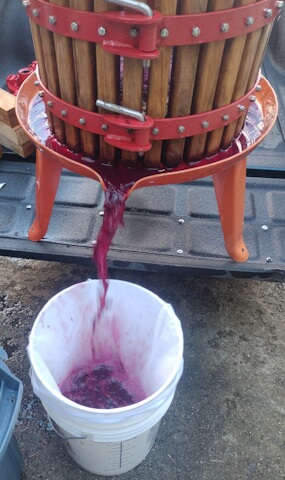
We started with the Avante, with the plan to rack as much wine as possible out of the fermenter, using my racking jig to keep the skins, pulp, and seeds out of the racking tube. The “jig” is a 4″ PVC pipe with a bunch of 1/4″ holes drilled in one end – it’s wrapped in a fine straining bag and plunged into the must. The racking tube goes inside — this keeps the solids out so the wine will flow.
The idea is to rack out as much wine as possible, so there’s less to carry around the house to the driveway where we press.
Note: the bag gets really ugly looking, and takes a bit of effort to clean after we are done, but it’s worth it.
This worked great with the Vidal, but didn’t work so well with the Avante, as we only racked about 1 US gallon out. I’m not sure why it didn’t work. The remainder was not heavy for two of us to carry, but it would have been nice to carry less.
The Chambourcin was really juicy, so when we poured the pomace into the press, a lot of wine flowed immediately without pressing. We grossed about 3 gallons, which was added to the racked wine.
We added about 1/3 of the pomace, then a layer of rice hulls, then another 1/3, more rice hulls, and the remaining pomace, plus more rice hulls. The Bravo will be dumped on top.
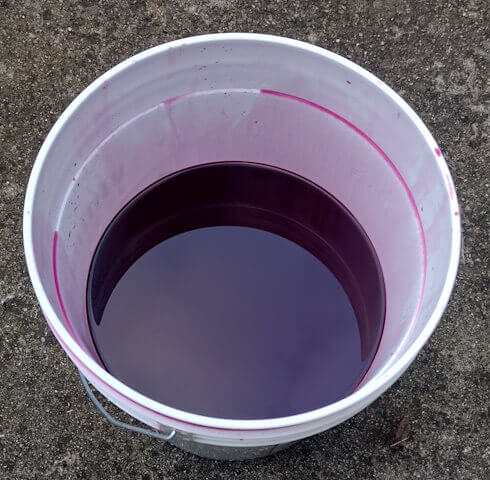
Racking the Bravo from beneath the cap worked far better, grossing about 3.5 gallons. I have no idea what the difference was.
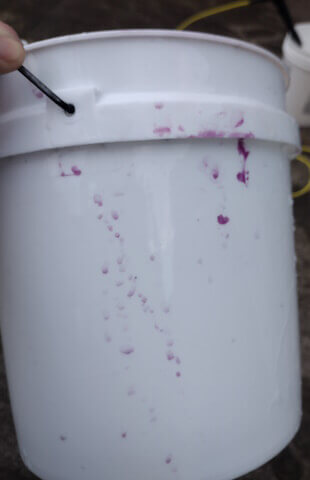
As mentioned these grapes are VERY juicy, so we had a lot just pour through the press before we applied pressure.
As we added the Bravo pomace, we did a couple more layers of rice hulls. At the current rate of usage, the 10 pounds I purchased last year will see us through 2030.
The rice hulls not only yield more wine from the pomace, they also speed up pressing. The wine flows better so pressing takes less time to express the wine.
I noted previously that the Chambourcin juice was dark coming out of the crusher. We added Scottzyme Color Pro, and that extracted even more color from the skins.
Beth (owner of the vineyard the grapes are from) commented on how amazing the color is when using Color Pro. In my opinion it’s worth the money.
But it does have drawbacks. The small food-grade bucket we use to collect pomace from the primary fermenter and dump into the press is stained. I used a pressure washer on the bucket and it didn’t remove the color. This wine WILL stain things.
When done pressing the cake is quite dry. The white-yellow in the picture is rise hulls.
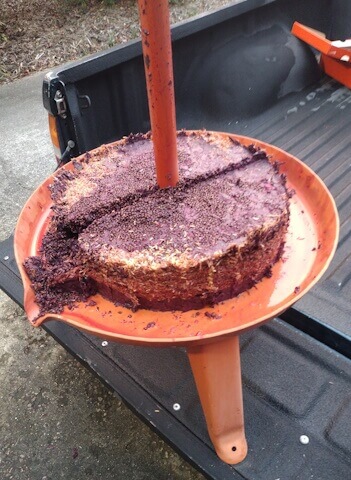
10/26/2023
I racked the Chambourcin tonight. First I racked the Avante carboy, adding 1/4 tsp K-meta even though it’s less than 19 liters. I tend to go a bit heavy on K-meta, which is still WAY below allowable levels.
The SG is still at 0.997, which is fine. I used to believe that reds normally drop to 0.996 or less, but looking through my records of over 110 batches, I discovered that my memory is extremely faulty.
This wine is DARK. double-D double-A double-R double-K
The juice was dark coming out of the crusher, and adding Color Pro made it darker. Not that it’s a problem, just an observation.
Also a caution, as this wine will stain things.
I filled a 4 liter jug and labeled it “Avante” and put the rest is a 23 liter carboy.
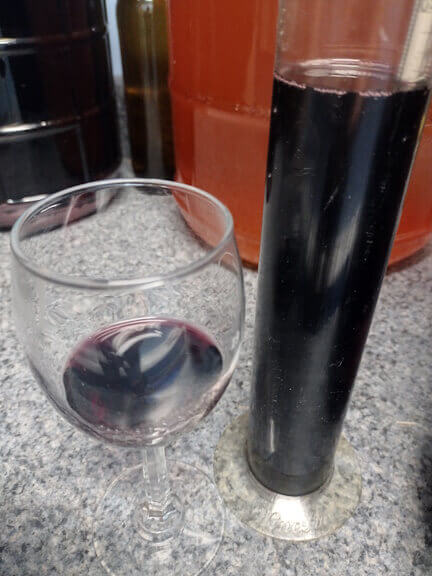
Next I racked the Bravo carboy, again adding 1/4 tsp K-meta. The SG is the same and it’s equally dark.
As with the Avante, I filled a 4 liter jug, labeled it “Bravo”, and added the remainder to the 23 liter carboy.
I taste tested these wines and they are night-n-day. The Avante has much less acid bite than the Bravo, which I hoped for as the Avante is supposed to eat 25-30% of the malic acid.
While I won’t decide until bottling time, I’m leaning towards using Avante for all French-American red hybrids, which tend to be high in acid. The acid reduction alone makes it worth it, although I need to consider the taste of the Bravo alone, an of the blend of the two.
Next I racked the combine carboy, which had the excess free run of both batches, plus the pressings. The taste of this one is in between the Avante and Bravo, which is to be expected. The wine is too green to be sure, and it needs acid reduction, but I expect to be pleased with this one.
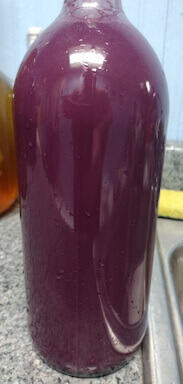
I goofed when racking this carboy, and sucked up a bit of sediment. When I realized it was happening I stopped the siphon, but the wine is muddy.
Oh, well, it fell once, it will fall again.
I filled the remaining space in the 23 liter carboy with this wine, then put the remainder in a pair of 4 liter jugs.
The sludge from the 3 carboys went into a 1.5 liter bottle. When I have room in the fridge, it will go in, although I expect it will start clearing within hours.
My current plan is that when the Vidal Juice currently in the fridge comes out in a week, I will swap in the Avante and Bravo jugs, and possibly the 2 other jugs. This will prove how much difference cold stabilization will make.
If it works as expected, in December or January I’ll put the carboy in a Brute, surround it with ice, and cold stabilize in that fashion. This type of acid reduction has far fewer side effects than any chemical alteration.
02/01/2024
Winemaking is a procrastinator’s hobby. I haven’t touched the Chambourcin in 3+ months.
I added 1-1/2 oz medium toast Hungarian cubes to the 23 liter carboy plus 1/4 tsp K-meta.
Next I racked the Avante and Bravo jugs — both dropped a LOT of acid and are much mellower than they were. The Avante is much fruitier than the Bravo, but has an acidic finish.
I think it’s because Avante eats 25-30% of the malic acid, and the bite of the malic still present in the Bravo masks the fruit. Since some of the malic is gone from the Avante, the remaining tartaric acid is more assertive in the finish.
Next I filled 1.5 liter bottles of the Avante and Bravo, respectively, for later taste testing. The remainder went into a bucket. There were several other 4 liter jugs plus smaller containers, and all were racked into the bucket. I added K-meta and racked it back into 4 liter jugs.
The wine definitely needs oak, so I added 1-1/2 oz medium toast Hungarian cubes to the 23 liter carboy, along with 1/4 tsp K-meta.
I’m considering cold stabilizing the 4 liter jugs for 3 weeks in the fridge to see what difference that makes in the acid.
02/06/2024
I moved 12 liters of wine into 4 liter jugs and put them in a small fridge to cold stabilize. I expect to leave them in the fridge for 3 weeks.
02/27/2024
Today I removed the three jugs from the fridge and racked into a 12 liter carboy. Surprisingly enough, none of the jugs dropped much acid.
I added 1/4 tsp K-meta to both the 12 liter and 23 liter carboys. It’s a heavy dose for the 12 liter carboy, so I may not add more prior to bottling.
10/22/2024
Bottling day!
We bottled 1 bottle each of the reserved Avante and Bravo wines. The remainder went into the main batch. These bottles will be opened in 3 or 4 months to compare against the main batch.
Next we racked the 23 liter carboy, which was aged on oak cubes, in a 20 gallon Brute. Then we racked the 12 liter carboy, which had been cold stabilized. These wines taste distinctly different, although the combination tastes better.
We like the wine, but it’s a bit acidic, so we added 15 oz glycerin and 1/2 tsp K-meta. The glycerin smooths it a bit, but it’s still not quite there.
We have a gallon of ’23 Merlot sitting on the shelf, so I drew 10 ml of it and 90 ml of the Chambourcin. THAT is much better. So we added the gallon of Merlot and bottled. The grand total is 56.5 bottles of wine.
